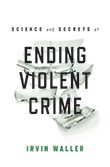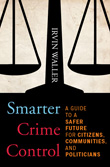Governments and development banks must make changes now to reduce violent crime significantly and achieve Sustainable Development Goals 16.1-.2 and 5.2 by 2030. These include:
1.Intergovernmental Organizations
- raise awareness of potential of prevention, build capacity of decision makers and planners, support city networks and foster shifts in national action
2.National Governments
- establish national offices to lead shift to prevention, promote policies to tackle roots, raise awareness of, and invest in, effective prevention, build capacity of decision makers and practitioners, measure outcomes, sùpport cities
3.Cities
- develop community safety and crime prevention offices and plans, implement tailored promising action
Irvin Waller on behalf of the International Organization for Victim Assistance (IOVA) called on the United Nations Commission for Crime Prevention and Criminal Justice to agree to urgent action to invest smartly in prevention to reduce significantly violent crime across the world. Here is the statement https://youtu.be/RQpI0oOsW2k (3 mins).
In 2015, the US along with government leaders from across the world agreed to make transformations to reduce significantly violent crime, gender based violence and violence against children. This commitment was made at the UN General Assembly as part of the UN Sustainable Development Goals (16.1, 16.2, 5.2) with the target date of 2030. But they have taken little if any action.
In 2021, the governments of the world agreed to advance evidence based prevention that tackles the causes of violence as a key component of the Kyoto Declaration adopted at the recent UN Congress on Crime Prevention and Criminal Justice in Kyoto.
Irvin Waller lauded this important support for prevention as a key to reducing the number of victims of violence significantly, but is calling for actions now to accelerate the significant changes needed to get smart investment in prevention and so significant reductions in numbers of victims of violent crime.
The challenge is significant in the US, particularly with homicides and domestic violence rising in 2020. The numbers of victims are also tragic annually on a world scale. But the saving of life and prevention of injuries and trauma is huge, given these estimates for the world:
- half a million persons will die as victims of violent crime and many more will be traumatized and seriously injured,
- thirty million women or more will be raped, and close to
- one billion children will be victims of violence.
The impact of these tragedies can be measured in trillions of dollars.
An ancillary event in Kyoto brought together experts who are international leaders in their field based in Africa, Canada, Europe, Latin America, and the US. They have backgrounds in government, intergovernmental agencies, cities and academia. Their solutions address the needs of cities in both high and low violence regions.
Irvin Waller presented evidence at that ancillary event on what has worked, the guidelines on how to tailor prevention, and the success stories like Bogotá and Glasgow as well as two new safety monitor tools. His presentation highlighted explanations from Science and Secrets of Ending Violent Crime – now also available in Spanish. This book presents the compelling case of what can be achieved by investing the equivalent of ten percent of what we spend on reaction in smart prevention.
These experts in Kyoto called for support of networks of cities committed to Agenda 2030 and four urgent actions to:
- invest adequately in prevention
- make decision makers and public aware of what works
- train human capacity to plan and guide governments and cities
- develop tools to monitor and set measurable goals
World leaders must shift the focus from criminal justice to crime prevention to reduce violence significantly. The leaders will not meet their commitment to UN Sustainable Development Goals (16.1, 16.2 and 5.2) by 2030, unless they invest now in proven programs, apply intergovernmental guidelines, and multiply successes, particularly in cities.
Covid has shown us the importance of prevention, evidence, and our ability to transform our policies quickly. Unfortunately, it has added urgency to tackling the causes of violence against women and children. Experts showed how affordable and popular actions now will prevent annually 100,000s of homicides, millions of women from intimate partner and sexual violence, and 100s of millions of young people from being victims of violence.
- Scientifically proven prevention programs identified by the World Health Organization and others that have reduced violent victimizations by 50% better than the reactive criminal justice system; These include services that outreach to youth, curricula to change attitudes to violence, support for parenting, income support, and reforms to policing.
- Guidelines on how to implement prevention effectively as agreed by the UN Economic and Social Council, UNODC, UN-Habitat and representatives from Latin American governments; These include offices for violence prevention, multi-sectoral ways to tackle causes, and measuring results.
- Cities that have reduced violence by 50% within just a few years. New networks of cities and national congresses share successful and proven experiences, train human talent, support monitoring and get political commitment to achieve reductions by 2030.
- The return on investment from the equivalent to 10% of what is currently spent on the reactive system of criminal justice. Smart investment now will not only reduce violence significantly but will achieve other SDGs and, particularly in high violence zones, will increase GDP, stop refugees fleeing violence, and foster the rule of law.
Additional information, including contacts with panelists, is available from iwaller@uottawa.ca

